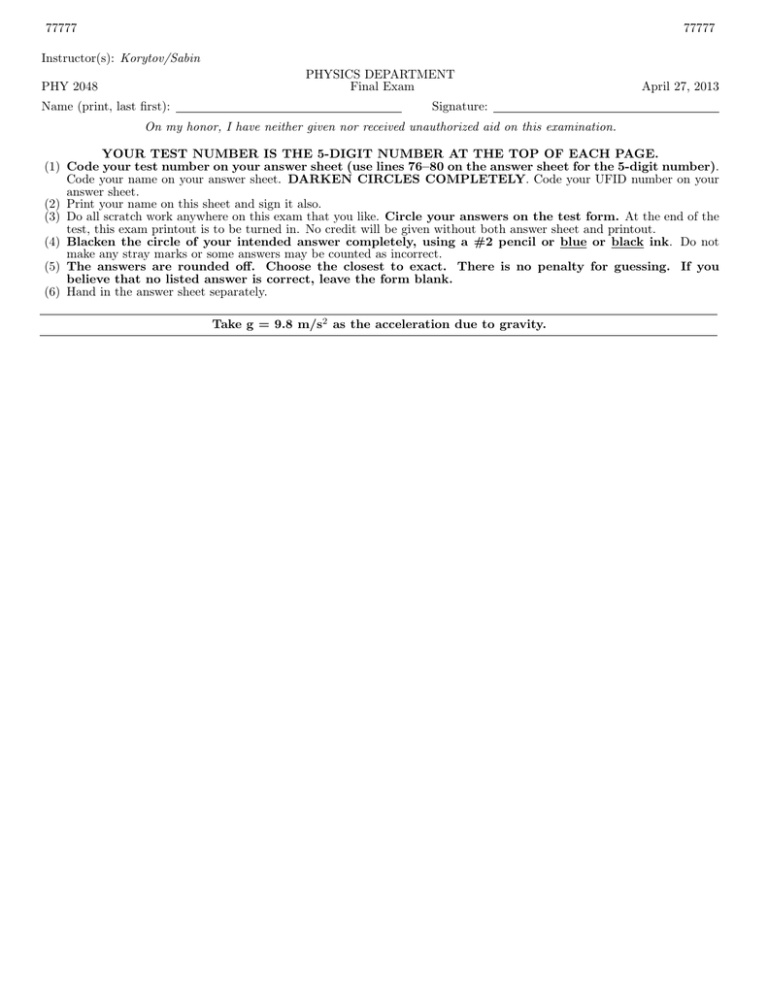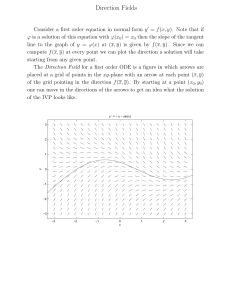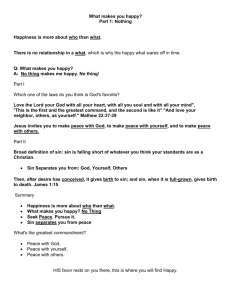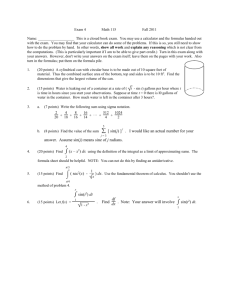77777 Korytov/Sabin PHYSICS DEPARTMENT PHY 2048
advertisement

77777 77777 Instructor(s): Korytov/Sabin PHYSICS DEPARTMENT Final Exam PHY 2048 Name (print, last first): April 27, 2013 Signature: On my honor, I have neither given nor received unauthorized aid on this examination. YOUR TEST NUMBER IS THE 5-DIGIT NUMBER AT THE TOP OF EACH PAGE. (1) Code your test number on your answer sheet (use lines 76–80 on the answer sheet for the 5-digit number). Code your name on your answer sheet. DARKEN CIRCLES COMPLETELY. Code your UFID number on your answer sheet. (2) Print your name on this sheet and sign it also. (3) Do all scratch work anywhere on this exam that you like. Circle your answers on the test form. At the end of the test, this exam printout is to be turned in. No credit will be given without both answer sheet and printout. (4) Blacken the circle of your intended answer completely, using a #2 pencil or blue or black ink. Do not make any stray marks or some answers may be counted as incorrect. (5) The answers are rounded off. Choose the closest to exact. There is no penalty for guessing. If you believe that no listed answer is correct, leave the form blank. (6) Hand in the answer sheet separately. Take g = 9.8 m/s2 as the acceleration due to gravity. 77777 77777 Take g = 9.8 m/s2 as the acceleration due to gravity. 1. An object is tnrown straight down with an initial speed of 2.5 m/s from a window which is 7.4 m above the ground. The time it takes the object to reach the ground is: (1) 1 s (2) 1.2 s (3) 1.5 s (4) 3 s (5) 1.7 s 2. A stone is thrown horizontally from the top of a 30-m high hill. It strikes the ground at an angle of 60◦ . With what speed was it thrown? 30 m 60o (1) 14 m/s (2) 20 m/s (3) 42 m/s (4) 28 m/s 3. Block A, with a mass of 5.0 kg, rests on a θ = 30◦ incline. The coefficient of kinetic friction is 0.10. The attached string is parallel to the incline and passes over a massless, frictionless pulley at the top. Block B, with a mass of 4.0 kg, is attached to the dangling end of the string. The acceleration of B is: (5) 48 m/s A B θ (1) 1.2 m/s2 , down (2) 1.2 m/s2 , up (3) 4.4 m/s2 , down (4) 4.4 m/s2 , up (5) 0 4. One end of a 1.0-m string is fixed, the other end is attached to a 2.0-kg stone. The stone swings in a vertical circle, passing the top point at 4.0 m/s. The string tension (in Newtons) at this point is about: (1) 12 (2) 0 (3) 20 (4) 32 (5) 52 5. An ideal spring is hung vertically from the ceiling. When a 2.0-kg mass hangs at rest from it, the spring is extended 10 cm. A downward external force is now applied to the mass to extend the spring an additional 6 cm. While the spring is being extended by the force, the work done by the spring is: (1) −1.5 J (2) −1.2 J (3) −36 J (4) 1.2 J (5) 1.5 J 6. The potential energy of a 0.20-kg particle moving along the x axis is given by U (x) = 8x2 − 2x4 , where U is in joules and x is in meters. When the particle is at x = 1.0 m, its acceleration is: (1) −40 m/s2 (2) 0 (3) −8 m/s2 (4) 8 m/s2 (5) 40 m/s2 7. A very massive object traveling at 10 m/s strikes a very light object, initially at rest, and the light object moves off in the direction of travel of the heavy object. Its speed is: (1) 20 m/s (2) 10 m/s (3) 15 m/s (4) 5.0 m/s (5) can’t tell from information given 8. A grinding wheel, used to sharpen tools, is powered by a motor. A knife held against the wheel exerts a torque of 0.80 N·m. If the wheel rotates with a constant angular velocity of 20 rad/s, the work done on the wheel by the motor in 1.0 min is: (1) 960 J (2) 0 (3) 480 J (4) 1400 J (5) 1800 J 77777 77777 9. A playground merry-go-round has a radius of 3.0 m and a rotational inertia of 600 kg·m2 . It is initially spinning at 0.80 rad/s when a 20-kg child crawls from the center to the rim. When the child reaches the rim, the angular velocity of the merry-go-round is (in rad/s): (1) 0.62 (2) 0.73 (3) 0.80 (4) 0.89 (5) 1.1 10. A 240-N block is suspended as shown. The beam AB is weightless and is hinged to the wall at A. The tension in the cable BC is: (1) (2) (3) (4) (5) 300 400 320 180 240 C 16 m N N N N N B A 12 m 240 N 11. The approximate value of g (in m/s2 ) at an altitude above the Earth’s north pole equal to one Earth diameter is: (1) 1.1 (2) 9.8 (3) 4.9 (4) 2.5 (5) 1.9 12. A projectile is fired straight upward from Earth’s surface with a speed that is half the escape speed. If R is the radius of Earth, the highest altitude reached, measured from the surface, is: (1) R/3 (2) R/4 (3) R/2 (4) R (5) 2R 13. A bucket resting on the floor of an elevator contains an incompressible fluid of density ρ. When the elevator has a downward acceleration of magnitude a, the pressure difference between two points in a fluid, separated by a vertical distance ∆h, is given by: (1) ρ(g − a)∆h (2) ρa∆h (3) ρg∆h (4) ρ(g + a)∆h (5) ρga∆h 14. A certain block of wood has a volume of 150 cm3 and floats on water (density = 1.0 × 103 kg/m3 ) with 25% of its volume submerged. The downward force that must be applied to hold it under water is about: (1) 1.1 N (2) 0.11 N (3) 0.37 N (5) 1.1 × 106 N (4) 1.5 N 15. A simple harmonic oscillator consists of a mass and spring (m, k). It oscillates as shown in (i) with period T . If the spring is cut in half and used with the same mass m, as shown in (ii), the period will be: √ (1) T / 2 (2) 2T √ (3) 2T (4) T (5) T /2 (i) (ii) m m 16. A meter stick is pivoted at a point a distance a from its center and swings as a physical pendulum. Of the following values for a, which results in the shortest period of oscillation? The moment of inertia of a stick of length L and mass 1 mL2 . m about its center is I = 12 (1) 0.3 m (2) 0.1 m (3) 0.2 m (4) 0.4 m (5) 0.5 m 77777 77777 17. A wave is described by y(x, t) = 0.1 sin(3x + 10t), where x is in meters, y is in centimeters, and t is in seconds. The wavelength is: (1) 2π/3 m (2) 6π m (3) 3π m (4) π/3 m (5) 0.1 cm 18. Two traveling sinusoidal waves interfere to produce a wave with a mathematical form y(x, t) = ym sin(kx + ωt + α). If the value of φ is appropriately chosen, the two waves might be: (1) (2) (3) (4) (5) y1 (x, t) = 0.7ym sin(kx + ωt) and y2 (x, t) = 0.7ym sin(kx + ωt + φ) y1 (x, t) = (ym /3) sin(kx + ωt) and y2 (x, t) = (ym /3) sin(kx + ωt + φ) y1 (x, t) = 0.7ym sin(kx − ωt) and y2 (x, t) = 0.7ym sin(kx − ωt + φ) y1 (x, t) = 0.7ym sin(kx − ωt) and y2 (x, t) = 0.7ym sin(kx + ωt + φ) y1 (x, t) = 0.7ym sin[(kx/2) − (ωt/2)] and y2 (x, t) = 0.7ym sin[(kx/2) − (ωt/2) + φ] 19. A source emits sound with a frequency of 1000 Hz. It is moving at 20 m/s toward a reflecting wall. If the speed of sound is 340 m/s, an observer at rest directly behind the source hears a beat frequency of: (1) 118 Hz (2) 11 Hz (3) 86 Hz (4) 97 Hz (5) 183 Hz 20. The speed of sound is 340 m/s. A plane flies horizontally at an altitude of 10,000 m and a speed of 400 m/s. When an observer on the ground hears a sonic boom, the horizontal distance from the point on its path directly above the observer to the plane is: (1) 6200 m (2) 5800 m (3) 8400 m (4) 12,000 m (5) 16,000 m





